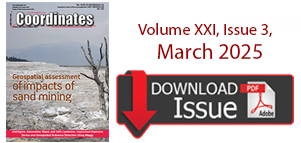| GNSS | |
The dangers of GPS/GNSS
|
||||
| GNSS (Global Navigation Satellite Systems) is a common acronym encompassing all existing and planned satellite-based navigation systems. So far, the US-built GPS dominates the scene completely, but the Russian GLONASS is approaching around-the-clock global operational status, and other systems are being developed (the European Galileo, the Chinese Compass/Beidou and the Indian IRNSS). There are also augmentation systems of more or less operational status (the US WAAS, the European EGNOS, the Japanese MSAS and the Indian GAGAN). Satellite navigation is becoming part of everyday life, user equipments are becoming cheaper, smaller, easier to handle and with increasingly improved performance. This development is expected to continue for the foreseeable future with receivers in mobile phones and cars as dominating markets (Figs. 1-3).
The following discussion for obvious reasons mostly refers to GPS, but the arguments are generally valid for all global navigation satellite-based systems. Actual performanceToday’s average performance of GPS is used as a starting point for our discussion. In not too distant a future, even better numbers can be expected. PDOP Availability: Requirement – PDOP of 6 or less, 98% of the time or better; Actual – 99.98%. Horizontal Service Availability: Requirement – 95% threshold of 36 metres, 99% of the time or better; Actual – 3.7 metres. Vertical Service Availability: Requirement – 95% threshold of 77 metres, 99% of the time or better; Actual – 5.3 metres. User Range Error: Requirement – 6 metres or less; Constellation Average Actual – 1.2 metres. Fig. 1. GPS users in 2006 What’s the problem?The problem is that nothing works 100 %. GPS is very close, but for some users under some circumstances,“very close” is not good enough. The situation in general is as follows: • Most GPS users know nothing about GPS vulnerability. • Most users don’t care. • Most GPS users can stand some interruptions or performance reduction. • Most politicians and representatives of authorities in the fi eld of navigation don’t know of GPS vulnerability. • Back-up systems are being closed down (e.g. LORAN-C), and there is little or no contact between different countries about these matters. GPS (and all satellite navigation systems, more or less) are vulnerabe because of • Very low signal power received; • A few frequencies (in the GPS case today, only one for general use)and a known signal structure; • Spectrum competition; • Worldwide military applications drive a GPS disruption industry; • Jamming techniques are well known, devices are available, or can be built easily (fig. 4). In 2001 (just before the infamous 9/11), the U.S. Department of Transportation’s Volpe National Transportation Systems Center published results from an investigation into the vulnerability of the transportation infrastructure relying on GPS. Conclusions to be drawn from that investigation are: • Awareness should be created in the navigation and timing communities of the need for back-up systems or operational procedures; • All transportation modes should be encouraged to pay attention to autonomous integrity monitoring of GPS/GNSS signals; • All GPS/GNSS receivers in critical applications must provide a timely warning when the signals are degraded or lost; • Development of certifiable, integrated (multipurpose) receivers should be encouraged; • A comprehensive analysis of GPS/ GNSS back-up navigation and precise timing options (e.g. LORAN, VOR/DME, ILS, INS) and operating procedures should be conducted. Fig. 2. Experienced and expected use of GPS/GNSS in cars Fig. 3. Experienced and expected use of GPS/GNSS in mobile phones Fig. 4. This dice is a 10 mW GPS jammer. Fig. 5. Example of a car navigation problem. Causes of troubleThere are many possible reasons for degraded performance or service interruption for users of GNSS: • Satellite or controlsegment malfunctions. • Unintentional interference: • Radio-frequency interference (RFI) from external sources (spectrum congestion, harmonics, high-power signals saturating receiver front ends); • Testing at system level; • Ionospheric infl uence (solar maxima, magnetic storms, scintillations); • Multipath. • Intentional interference: • Jamming; • Spoofing (false signals into the receiver); • Meaconing (interception and re-broadcast of navigation signals). • Human factors: • User equipment and satellite design errors; • Over-reliance; • Lack of knowledge and/or training. The main technical explanation of GNSS receiver vulnerabilities to external interference can be summarised as very low power received from the satellites. The minimum power level is usually between -150 and -160 dBW. Looking at the details for GPS, we see that • acquisition requires 6 – 10 dB higher signal-to-noise ratio (SNR) than tracking, • loss-of-lock sometimes occurs for interference-to-signal ratios (I/S) below 30 dB, • receiver detection of loss-of-lock is delayed because of narrowband code-tracking loops, • some lines in the GPS C/A-code spectrum are more vulnerable than others because of higher power levels (Gold code spectra do not exactly follow a sinc shape, and spectral lines work as local oscillator frequencies for received interference signals), • modulated interference is generally worse than white noise, and narrowband interference is worse than wide-band. |
Pages: 1 2


















 (33 votes, average: 1.67 out of 5)
(33 votes, average: 1.67 out of 5)





AGREED……………………….
Leave your response!